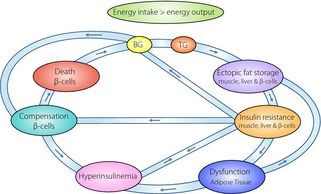Figure 1.

Simplified overview of the interactions between multiple tissues in type 2 diabetes. When energy input exceeds output, both blood glucose (BG) and blood triglycerides (TG) will increase, which eventually lead to ectopic fat accumulation in muscle and the liver. The consequence is insulin resistance, thus directing lipids to the adipose tissue. When the adipocytes become dysfunctional, extra ectopic fat accumulation including fat accumulation in the β‐cells occurs. Whether insulin resistance brings about hyperinsulinemia or vice versa is a highly debated topic. An increase in BG and insulin resistance both lead to induction of β‐cell compensatory mechanisms including β‐cell hypertrophy and increased insulin secretion, further contributing to hyperinsulinemia. This is a vicious cycle of first physiological events, then pathological events, and finally β‐cell death leading to a severe BG increase and full‐blown diabetes.
